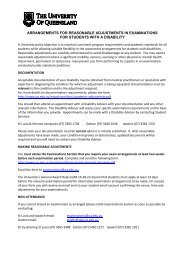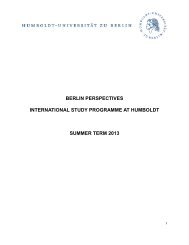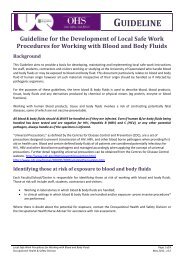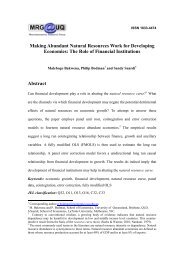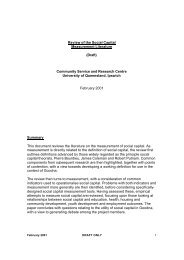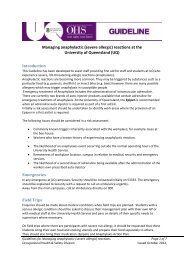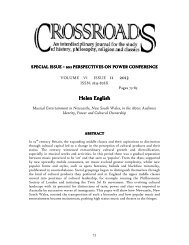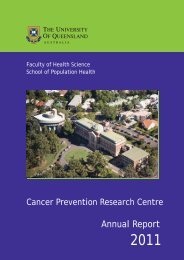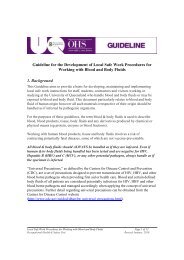Managing Traffic Incidents - University of Queensland
Managing Traffic Incidents - University of Queensland
Managing Traffic Incidents - University of Queensland
You also want an ePaper? Increase the reach of your titles
YUMPU automatically turns print PDFs into web optimized ePapers that Google loves.
A Management Tool for Investigating<br />
Road Investment Choices<br />
by Gary Hayes and Brad Lawrence, Booz·Allen & Hamilton<br />
R<br />
oads are big business, with the<br />
operational and capital budgets <strong>of</strong><br />
road's authorities in developed<br />
countries <strong>of</strong>ten approaching or<br />
exceeding the turnover <strong>of</strong> the largest global<br />
commercial corporations. In addition, the<br />
political pressure for the efficient and effective<br />
allocation <strong>of</strong> public funds requires the<br />
optimal allocation <strong>of</strong> these scarce financial<br />
resources to road maintenance and capital<br />
works programmes. Very <strong>of</strong>ten, the commercial<br />
principles, and hence financial transparency,<br />
within which road's authorities are<br />
expected to operate make it critically important<br />
for them to be able to justify and motivate<br />
spending allocations.<br />
HDM-4 is a planning and management tool<br />
developed for road's authorities to be able to<br />
make technical based financial road investment<br />
choices. The development <strong>of</strong> the HDM-4<br />
(Highway Development & Management) suite<br />
<strong>of</strong> programs was funded by the World Bank,<br />
and carried out at the <strong>University</strong> <strong>of</strong> Birmingham<br />
in the United Kingdom. Extensive further<br />
research into the physical and economic<br />
relationship <strong>of</strong> roads in India, Kenya, Brazil<br />
and the Caribbean have resulted a much<br />
improved product, and the latest (4 th ) version<br />
<strong>of</strong> the program <strong>of</strong>fers some improvements<br />
over version three, specifically:<br />
– effects <strong>of</strong> traffic congestion<br />
– simulation <strong>of</strong> rigid pavements and a range<br />
<strong>of</strong> flexible pavement types<br />
– effects <strong>of</strong> road texture and skid resistance<br />
– effects <strong>of</strong> freeze-thaw conditions<br />
– traffic safety effects<br />
– environmental impacts<br />
HDM-4 Applications<br />
Essentially HDM-4, based on the models <strong>of</strong><br />
road deterioration and maintenance, together<br />
with user cost inputs, determines the net<br />
financial benefits and hence enables project<br />
prioritisation to be determined within specified<br />
budget constraints. The economic analysis<br />
can be performed using the full life cycle<br />
approach (say 15 to 20 years), or the budget<br />
life cycle approach (say 3 to 5 years).<br />
HDM-4 enables the following types <strong>of</strong><br />
technical, economic and policy applications to<br />
be undertaken:<br />
– Individual project financial and technical<br />
evaluation<br />
– Project formulation<br />
– Road network maintenance needs forecasting<br />
– Road network upgrade programme formulation<br />
– Network strategic planning<br />
– Technical standards investigations<br />
– Vehicle policy investigations (e.g. axle<br />
limit investigations and road fleet changes)<br />
– Road use cost and damage attribution,<br />
particularly in the context <strong>of</strong> transport<br />
pricing and taxation<br />
It is important to note that HDM-4 is not a<br />
replacement for any existing management and<br />
planning tools, such as pavement management<br />
systems (PMS's), and nor is it a database tool.<br />
Rather, it should be seen as a complementary<br />
management tool, used in conjunction with<br />
other road infrastructure planning tools.<br />
HDM-4 Input Requirements<br />
To be able to fully utilise the program a substantial<br />
amount <strong>of</strong> input data is required. This<br />
data defines the road network, road conditions,<br />
maintenance resource data, productivity<br />
data, unit costs, economic parameters, fleet<br />
definition and volumes, environmental issues,<br />
maintenance cycles and road congestion<br />
levels. This data is <strong>of</strong>ten available from other<br />
sources, such as strategic transportation planning<br />
tools such as Emme/2 and TransCAD,<br />
pavement management systems, etc.<br />
An important aspect <strong>of</strong> the input, is the<br />
pavement deterioration pr<strong>of</strong>iles, which ideally<br />
should be based on historical pavement research<br />
and practical experience.<br />
16 DECEMBER 2001


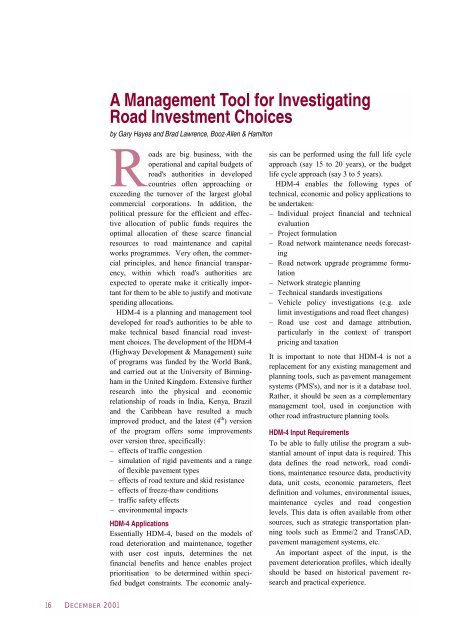

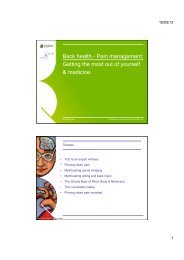
![Recycling [ PDF, 62KB ] - University of Queensland](https://img.yumpu.com/51805185/1/184x260/recycling-pdf-62kb-university-of-queensland.jpg?quality=85)
